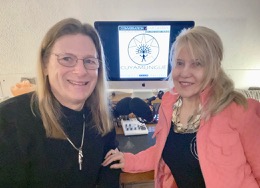
Listen to these podcasts of interviews with Cuyamungue Institute Directors Laura Lee and Paul Robear. Send a message to schedule an interview, and share a little about your work: contact Paul & Laura
ABOUT Paul Robear & Laura Lee
Short Bio: For over 20 years, Laura Lee & Paul Robear, husband and wife team, have practiced and taught Ritual Body Postures, which they describe as “the modern version of a very ancient technique for naturally and easily shifting into an expanded state of awareness, a form of ‘waking dream’ characterized by the experience of a ’spirit journey.’ They are Directors of the Cuyamungue (Kwee-ah-mong-gay) Institute, the world headquarters for this practice, founded by anthropologist Dr. Felicitas Goodman.
About the Institute: The Cuyamungue Institute (CI), is a 501-c-3 non-profit educational research organization founded by the late anthropologist Felicitas D Goodman. Laura and Paul worked with Dr. Goodman the last ten years of her life and since 2000 have taught this work around the world, teach and speak widely at online and in-person events, write the CI website, newsletter, articles, social media, manuals, add to the research and to CI’s extensive, 50-year collection of archives, and more.

AVAILABLE For Speaking Engagements.
Laura Lee and Paul travel extensively as presenters and workshop teachers. As CI’s Directors since 2011, they teach at CI’s worldwide headquarters in Santa Fe New Mexico with a full schedule of workshops during the summer season. Winters were spent traveling, teaching, and speaking internationally, most recently in Munich, Paris, London, Malta and Sydney, Australia. They enjoyed the opportunity to add another venue in 2017, when they were invited to collaborate with artist Mel O’Callaghan to bring CI’s Ecstatic Trance Posture Ritual to a modern art exhibit at the Palais de Tokyo in Paris, where they also choreographed a performance piece, and gave a one-day workshop for over 100 art students at the New School Parsons Paris. Laura wrote the script and narrated a short video, “The Cuyamungue Institute: Bridging Two Worlds” filmed and produced by filmmaker Mark J. Gordon.
Connecting with coincidence – Bernard Beitman, M.D.
The Universal Dancer Podcast – Leslie Zehr
Laura Lee & Paul Robear love to talk their work with Ecstatic Trance: Ritual Body Postures.
ASK THEM ABOUT:
8-10 Interview Questions:
- There are many techniques for spirit journeying, what is unique about this?
- Who first decoded these postures as “ritual instructions” as depicted in ancient art, and when?
- How did you get involved in this work?
- What roles do postures play?
- Briefly, what was the evidence that led Dr. Goodman to this in the 1960’s?
- What else did Dr. Goodman do, to this put this long-lost spiritual practice back on the map for our time?
- What did the laboratory tests find, as indicators of this natural physiological shift that supports an alerted state of mind?
- How far back in time do these artifacts go?
- How are they related to Yoga Postures?
- What are the typical experiences, or range of experiences, with Ritual Body Postures?
- What are the benefits, and is there a deeper meaning to these experiences?
- Can anyone do this? What’s required?
- What is ecstatic about this state of what Goodman called “Ecstatic Trance?”
- How has this added to your lives, personally? How has this changed your perspective on life in general, and your life, personally?
- What keeps you fascinated, what keeps you going, after decades with this work?
- What does this perhaps indicate about the nature of reality?
- You offer free, and open to anyone sessions over Zoom, why do you suppose you find this works equally well on Zoom, as it does in person, when practiced with a group?
Facebook links to tag to: https://www.facebook.com/CuyamungueInstitute/

